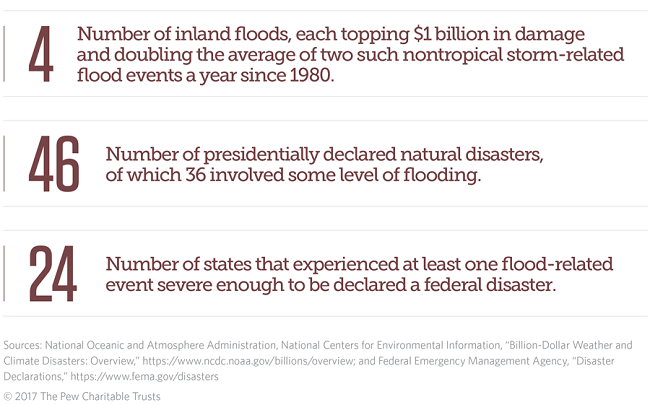Spring is here – finally! Maybe it’s just me, but winter seemed to linger a little longer this year. While spring brings with it the joys of blue skies, warmer temperatures, and blossoming buds, it can also produce an abundance of rain. And with the rain comes the possibility of flooding. Fortunately, you can reduce your risk of damage caused by flooding with some tips for flood season preparedness.
Flooding is the most common natural disaster in the United States. Because flooding can be caused by a number of reasons – severe storms, continuous rainfall, failure of dams and levees, clogged drainage systems, pipes bursting – communities all across the nation can experience flooding. Flooding is also one of the most costly natural disasters in our nation. According to the Federal Emergency Management Agency (FEMA), just one inch of water in your home can cause over $27,000 in damage!

Know your risk.
FEMA's Flood Map Service Center allows you to see the flood risk for your home. These flood zone maps delineate areas most at risk of flooding and are available for public use. Just enter your address to view the flood map results for your area.
Consider purchasing flood insurance.
Beware that most homeowner’s insurances do not cover flooding. Because of that, most mortgage companies will require you to purchase a separate flood insurance policy if your home is located in a high-risk area. Flood insurance premium rates usually correspond to the flood zone level in which your home is located (based on FEMA’s MSC flood maps, mentioned above). The higher the degree of risk, the higher your insurance premium will be.
Keep your family safe.
Make a family emergency plan. There are excellent resources available to help you create your family’s emergency plan, such as Ready.gov and American Red Cross. Every family should create a basic plan, but take extra precautions if you are in a high-risk flood zone.
Once you have a written plan established, be sure to communicate it to all family members so that everyone knows how to respond. Designate a location to store your emergency plan that is easily accessible to all, in case you are not home when an emergency arises. Finally, discuss basic flood safety tips with your children:
- Stay away from areas subject to flooding. Do not play near creeks, streams, ditches, storm drains, or culverts.
- Do not swim or play in flood water. Flood waters can be contaminated, electrified, or filled with dangerous debris. Snakes can also be an issue as flood waters often flush them from their homes.
- Do not walk through moving water. Just a few inches of rushing water can sweep you off your feet. If you encounter flooding, turn around or climb to higher ground. If you become trapped, call 9-1-1 immediately.
Protect your property.
There are a few items you can install in your home that will help prevent extensive damage during a flood:
- Check/backflow valves to prevent sewer lines from backing up into your home’s drains.
- A sump pump system in your basement.
- A flood detection device, also know as a water monitor or water sensor. This device connects to your NWOSS security system and will signal an alarm when it senses water. If your using the Virtual Keypad app, you can also receive flooding alerts on your phone. To add a water monitor to your security system, call us today at 800-833-6416.
If you are located in a high risk flood zone, you may want to consider more extensive options to protect your property. Check out FEMA’s Homeowner’s Guide to Retrofitting for more information.
Add a water monitor to your security system
Resources:

